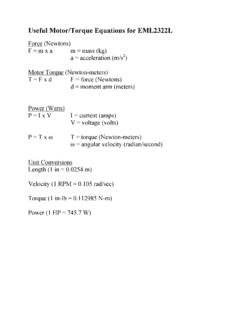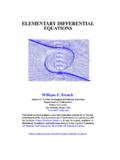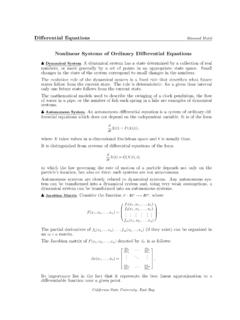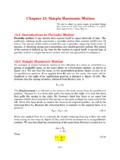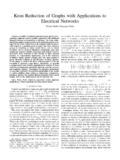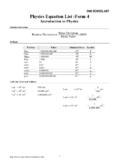Transcription of Georgia Standards of Excellence Curriculum Frameworks ...
1 These materials are for nonprofit educational purposes only. Any other use may constitute copyright infringement. Georgia Standards of Excellence Curriculum Frameworks GSE Grade 6 Unit 4: One Step equations and Inequalities Mathematics Georgia Department of Education Georgia Standards of Excellence Framework GSE Grade 6 Mathematics Unit 4 Mathematics Grade 6 Unit 4: One Step equations and Inequalities Richard Woods, State School Superintendent July 2016 Page 2 of 96 All Rights Reserved Unit 4 One Step equations and Inequalities TABLE OF CONTENTS OVERVIEW ..3 Standards FOR MATHEMATICAL PRACTICE ..4 Standards FOR MATHEMATICAL CONTENT.
2 5 BIG IDEAS ..6 ESSENTIAL QUESTIONS ..6 CONCEPTS & SKILLS TO MAINTAIN/ FLUENCY ..7 STRATEGIES FOR TEACHING AND LEARNING ..8 MISCONCEPTIONS ..9 SELECTED TERMS AND SYMBOLS ..9 INSTRUCTIONAL RESOURCES/TOOLS ..11 FORMATIVE ASSESSMENT LESSONS (FAL) ..11 SPOTLIGHT TASKS ..12 3- ACT TASKS ..13 Set It Up ..15 Building with Toothpicks (Spotlight Task) ..22 Fruit Punch (Spotlight Task) ..26 Graphing Stories ..30 Making Sense of Graphs ..43 Analyzing Tables ..50 Who Has Faulty Thinking? (FAL) ..55 Real-life equations (FAL) ..56 When is it Not Equal? ..57 Evaluating Statements about Number Operations (FAL) ..63 It s on Sale! ..64 The Catering Job.
3 67 Culminating Task: Want UNIT WEB LINKS ..78 Georgia Department of Education Georgia Standards of Excellence Framework GSE Grade 6 Mathematics Unit 4 Mathematics Grade 6 Unit 4: One Step equations and Inequalities Richard Woods, State School Superintendent July 2016 Page 3 of 96 All Rights Reserved OVERVIEW In this unit students will: Determine if an equation or inequality is appropriate for a given situation. Solve mathematical and real-world problems with equations . Represent real-world situations as inequalities. Interpret the solutions to equations and inequalities. Represent the solutions to inequalities on a number line.
4 Analyze the relationship between dependent and independent variables through the use of tables, equations and graphs. Beginning experiences in solving equations will require students to understand the meaning of the equation as well as the question being asked. The use of illustrations, drawings, and balance models to represent and solve equations and inequalities will help students to develop this understanding. Solving equations will also require students to develop effective strategies such as fact families, and inverse operations. As effective strategies are developed, students will revisit rate and proportional reasoning problems and solve them using strategies developed in solving similar one-step equations .
5 Students will represent and model equations and inequalities that are based on mathematical and real-world problems. Presented with these situations, students must determine if a single value is required as a solution or if the situation allows for multiple solutions. This creates the need for both equations (single solution for the situation) and inequalities (multiple solutions for the situation). When working with inequalities, students will work with situations in which the solution is not limited to the set of positive whole numbers but includes positive rational numbers. As an extension to this concept, certain situations may require a solution between two numbers.
6 Therefore, the exploration with students as to what this would look like both on a number line and symbolically will be explored. The process of translating between mathematical phrases and symbolic notation is essential in the writing of equations and inequalities for a situation. This is a two-way process and students will be able to write a mathematical phrase for an equation. The goal is to help students connect the pieces. This is done by having students use multiple representations for mathematical relationships. Students will translate freely among the story, words (mathematical phrases), models, tables, graphs and equations /inequalities. Given any one of these representations, students should be able to develop the others.
7 Georgia Department of Education Georgia Standards of Excellence Framework GSE Grade 6 Mathematics Unit 4 Mathematics Grade 6 Unit 4: One Step equations and Inequalities Richard Woods, State School Superintendent July 2016 Page 4 of 96 All Rights Reserved Standards FOR MATHEMATICAL PRACTICE 1. Make sense of problems and persevere in solving them. Students choose the appropriate algebraic representations for given contexts and can create contexts given equations or inequalities. 2. Reason abstractly and quantitatively. Students represent a wide variety of real-world contexts through the use of real numbers and variables in mathematical expressions, equations , and inequalities.
8 Students contextualize to understand the meaning of the number or variable as related to the problem and decontextualize to manipulate symbolic representations by applying properties of operations. 3. Construct viable arguments and critique the reasoning of others. Students construct arguments using verbal or written explanations accompanied by expressions, equations , inequalities, models, graphs, and tables. 4. Model with mathematics. Students model problem situations in symbolic, graphic, tabular, and contextual formats. Students form expressions, equations , and inequalities from real-world contexts and connect symbolic and visual representations. 5. Use appropriate tools strategically.
9 Students use number lines to graph equations and inequalities. Students use tables to organize information to write equations and inequalities. 6. Attend to precision. Students precisely define variables. 7. Look for and make use of structure. Students seek patterns or structures to model and solve problems using tables and equations . Students seek patterns or structures to model problems using tables and inequalities. Students apply properties to generate equivalent expressions ( 6 + 2x = 3 (2 + x) by distributive property) and solve equations ( 2c + 3 = 15, 2c = 12 by subtraction property of equality, c = 6 by division property of equality). 8. Look for and express regularity in repeated reasoning.
10 Students generalize effective processes for representing equations and inequalities based upon experiences. Students will be solving for equations . Standards FOR MATHEMATICAL CONTENT Reason about and solve one-variable equations and inequalities. Understand solving an equation or inequality as a process of answering a question: which values from a specified set, if any, make the equation or inequality true? Use substitution to determine whether a given number in a specified set makes an equation or inequality true. Use variables to represent numbers and write expressions when solving a real-world or mathematical problem; understand that a variable can represent an unknown number, or, depending on the purpose at hand, any number in a specified set.










